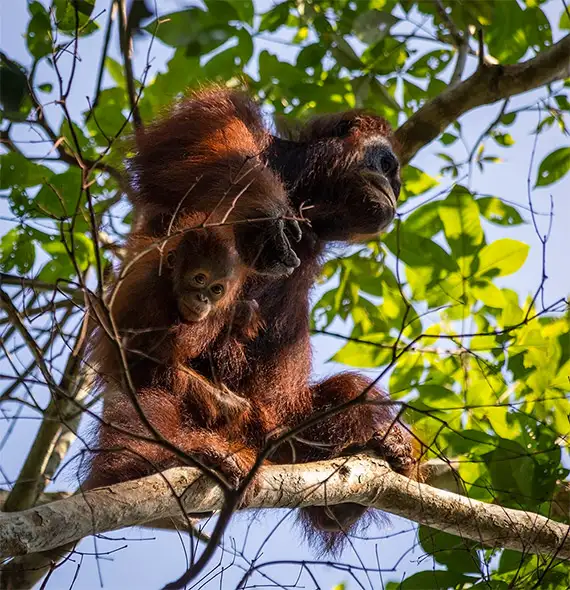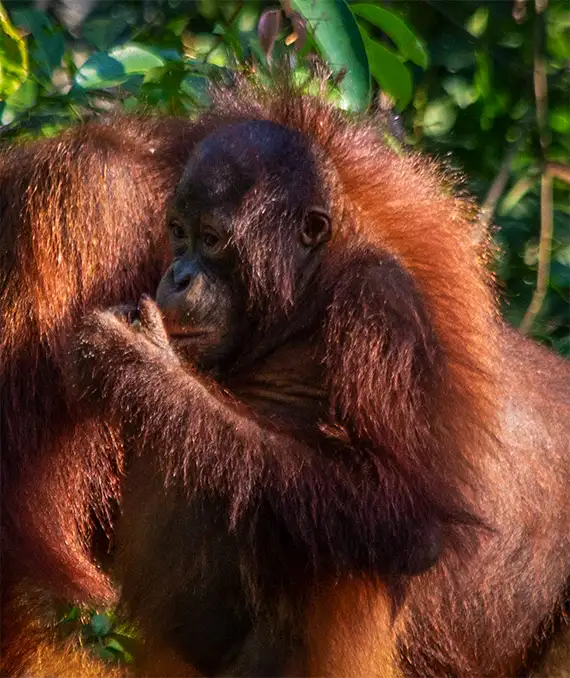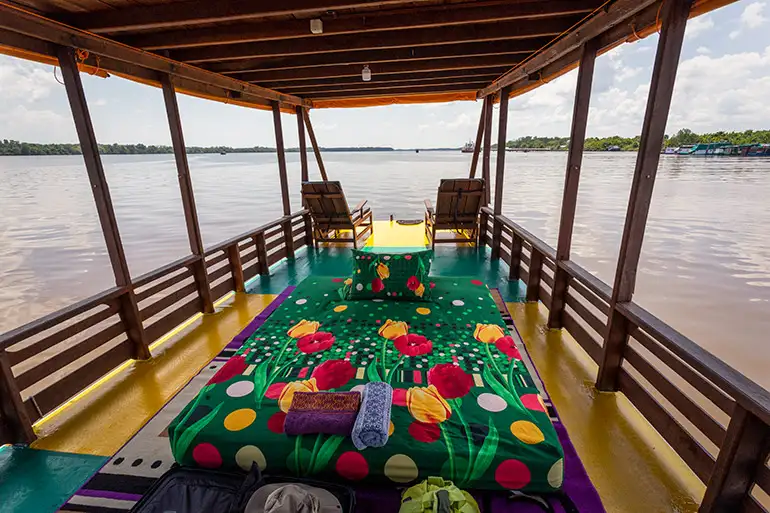Wild Orangutan Safari in Indonesia – the Complete Guide
After more than 24 hours in the air, I am thrilled to be on solid ground. The airport in Jakarta is glossy, a pleasant surprise in the developing world. The line through immigration is moving quickly. Finally, it’s my turn. “Hello,” I say to the man behind the glass and hand him my passport. He glances at the little blue book. “Where are you staying?” he asks. “Tanjung Puting,” I say. He looks confused. “Bali?” I bite my lip. I guess Bali would be a more predictable choice. “No, Pangkalan Bun,” I respond. A slight pause as he stares at me in confusion. “Where is that?” he finally asks. “Borneo.” He says nothing else but places a silent stamp in my passport. I don’t blame him for not knowing where I am going. Truth is, few westerners will visit my final destination. That destination is the Tanjung Puting National Park, located next to the city of Pangkalan Bun, on the island of Borneo. What follows below is a complete guide to the wild orangutan safari in Indonesia. The definitely-not-Bali island of Borneo awaits you.
Looking for even more off-the-beaten-path adventure in Indonesia? Check out the Lombok, Indonesia One Week Itinerary.

Before we get started, I would love to thank my long-time sponsor Vero Social Network. Vero is an add free, algorithm free social media platform where you can share your interests in a welcoming and supportive environment. Join me on Vero for lots more about the orangutan safari and many other adventures.
Please note: This blog post may contain some affiliate links. More info.
How to Prepare to Visit Orangutans in Indonesia
Before you get on a plane, before you fly halfway around the world and before you attempt to explain to the guy in immigration exactly where you are going, you’ll need to prepare to visit Borneo. Getting ready for an orangutan safari means you need to consider the recommended vaccination schedule, book a tour, book an internal Indonesia plane ticket (harder than it sounds), and finally purchase the right supplies. Don’t worry – I just went through this process and I’ll take you through it step by step.
Step 1: Consider the vaccinations
The CDC recommends a lot of vaccinations for visiting Indonesia. More importantly, as you are going into the jungle you should also consider getting all the “some travelers” vaccinations on the list. This includes Hepatitis B, Japanese Encephalitis and rabies. Keep in mind that there is no malaria in Borneo (as of December 2019) and no yellow fever.
In addition, before you go, buy medical evacuation insurance. Panhkalun Bun is so isolated, that when I went to get a massage at the only spa in town, the employees all wanted to take a picture with me. Probably not a place with great medical facilities. Check out TravelGuard insurance for the best coverage in Indonesia.
 The uppermost deck of my boat. Admittedly we did not spend much time up here but it was beautiful nevertheless. Instead, we spend lots of time on the lounge chairs on the main deck.
The uppermost deck of my boat. Admittedly we did not spend much time up here but it was beautiful nevertheless. Instead, we spend lots of time on the lounge chairs on the main deck.
Step 2: Book a tour
Next, its time to book a tour. There are many tour operators in Pangkalan Bun – but only a few licensed ones. For ethical travel, be sure to book one of the licensed orangutan safari tour operators in the area. Using a licensed operator will only cost you a few dollars more, but will pay off a hundred-fold for the environment around you. In addition, ask your tour operator to make sure they assign you a licensed guide. Again, only a few of the guides are licensed, and they are properly trained and well-compensated. Just like licensed tour operators, a licensed guide is a great investment.
While in Borneo, I traveled with Orangutan Applause, a small but licensed tour operator operated by a former park ranger. I really enjoyed the trip and can totally recommend this company.
 Beney and I have been friends for many years. She is currently living in Indonesia and so we took the opportunity to travel together. Allen, our guide, is holding up his official badge. Your licensed tour guide should have a badge just like this one. Before you book with the agency ask them if they are licensed by the government. Next, ask if they can give you a licensed guide with a badge. Please note I blurred out some of Allen’s details on his badge for his privacy.
Beney and I have been friends for many years. She is currently living in Indonesia and so we took the opportunity to travel together. Allen, our guide, is holding up his official badge. Your licensed tour guide should have a badge just like this one. Before you book with the agency ask them if they are licensed by the government. Next, ask if they can give you a licensed guide with a badge. Please note I blurred out some of Allen’s details on his badge for his privacy.
Step 3: Book a ticket from Jakarta to Pangkalan Bun
Your next step will be to get from Jakarta to Panaklan Bun. This area does not have an international airport, and access by boat is complicated.
Due to Puting National Park’s remote location, your best bet is to fly into PKN, the local airport. I usually recommend that you use Skyscanner to book tickets. However, PKN flights are a bit complicated. Most of the tickets are only sold on internal Indonesian websites and do not accept American credit cards.
As an alternative, you can usually book the tickets using your tour operator. There is no premium if you purchase the tickets through your tour operator, but do temper your expectations. The operators tend to take a while to respond and are not yet familiar with providing western quality customer service. You might need to prompt them a few times and follow up closely to book your tickets.

Step 4: Buy the right supplies
Before you go, it is important that you pack the right supplies for this trip. As I mentioned, Pangkalun Bun is remote and does not have a great commercial district. Therefore, you should bring everything you need with you.
Before you go, make sure you have the following supplies:
- A light rain jacket is a necessity in the jungle
- Full-length light hiking pants to help keep the bugs away
- A safari-style hat for the bugs and the sun
- Hiking boots or sneakers for the jungle walks
- A light backpack to carry your supplies
- A great camera for your pictures
- A zoom lens to help you take those amazing animal shots
- Bug spray (no explanation needed)
- Sunblock – a must under the jungle sun
- Hiking socks to keep your dry
- A water bottle – refill your bottle with clean water on the boat. Ask your tour operator to make sure you have clean water to refill your bottle.

Orangutan Safari FAQS
How long should your orangutan safari take?
The most popular tours are 3 days, 2 nights. Other options are available, but this length gives you the most bang for the buck. In the three days, you can visit four feeding stations, a local village, plant a tree and do a night jungle walk. You’ll also have a chance to spend plenty of time on the river, enjoying the breeze and observing the crocodiles.
 A critically endangered Hornbill, as seen from the deck of our little boat.
A critically endangered Hornbill, as seen from the deck of our little boat.
What kind of boat should you book?
Most people choose to tour the park by boat. Getting around the national park on foot is difficult, but possible and would require you to camp overnight. Another option is to lodge in a homestay in one of the local villages. For more information on the camping and homestay options, contact the tour operators.
However, if you chose to stay on a boat, you’ll spend the 3 days on a small wooden boat designed specifically for the orangutan safari tours. When you book, you have a choice of a boat with air conditioning and one without. Of course, it is more environmentally friendly to stay in a boat with no air conditioning. If you chose this option, you’ll get to sleep on the deck, and the breeze is sufficient air conditioning for most people. If, on the other hand, you are traveling with people very sensitive to heat or older folks, an air-conditioned boat might be a better choice.
 The standard boats are open air. The tourists sleep on the deck (under a mosquito netting) and the staff sleep below deck. There are four staff members on board – the guide, the captain, the cook, and the shipmate.
The standard boats are open air. The tourists sleep on the deck (under a mosquito netting) and the staff sleep below deck. There are four staff members on board – the guide, the captain, the cook, and the shipmate.
When should you go to the Orangutan safari in Indonesia?
Before you book, keep in mind the rainy season. We went over Thanksgiving in late November. It was an ideal time to go because there was almost nobody there, yet the weather was great most of the time. Some people who traveled in the heart of dry season mentioned that the feeding stations got crowded. We encountered no more than 3 or 4 boats at every station, and no more than a dozen other tourists at any one time. My suggestion would be to go during the shoulder season, which is November or March.

Why should you go on the orangutan safari in Indonesia?
In addition to the obvious reason (it’s an incredible adventure), a trip to Borneo is one way to help the orangutans. You might already know, palm oil plantations are a major contributor to deforestation in Indonesia. However, not all hope is lost. Small tour operators are continually buying up national-park-adjacent virgin jungle from local sellers. By traveling with such a tour operator you are helping them buy more land, land which will stay virgin. In addition, you are providing non-farm jobs to the local people. Thus, you are giving the local residents a non-plantation income for today and a reason to help preserve the jungle for tomorrow.
In addition to visiting Borneo, you can help the orangutans by donating to orangutan.org. Bonus – if you become a sponsor you can visit the facilities during your safari and meet some of the babies. The facility is only open to sponsors. Definitely a win/win.

Where to stay after the orangutan safari
After you are done with the orangutan safari, you will have two options. The first is to go back to the airport and fly to Jakarta. The second is to stay in town overnight. We chose to stay in Pangkalan Bun because we did not want to rush through our last day. It was a great decision as it gave us an opportunity to take a hot shower, and to recharge in an air-conditioned room.
The good news is that it is not difficult to pick a hotel in Pankalan Bun. The bad news is that there are only a couple of hotels in town, so your options are limited.
- The Swiss Belinn is a slightly fancier choice and is around 2 to 3 stars by western standards. At about $40 a night it’s the most expensive option in the area.
- The Arsela Hotel is even more affordable and incorporates traditional design elements.
The town of Pangkalan Bun is pleasant and walkable. There are a few restaurants in the area, a couple of spas and some shops. I did not explore much but felt very safe and comfortable walking about 10 blocks to and from a spa.
 Although orangutans are not normally social, they do have a chance to interact with one another at feeding stations in the Tanjung Puting National Park.
Although orangutans are not normally social, they do have a chance to interact with one another at feeding stations in the Tanjung Puting National Park.
I hope you have enjoyed this complete guide to planning your own orangutan safari. If you found it helpful, I have a favor to ask. Please leave a comment or share the article on social media; both of those actions help search engines learn that the article is valuable. Thank you for reading and I’ll see you on the road (or in the jungle)!

